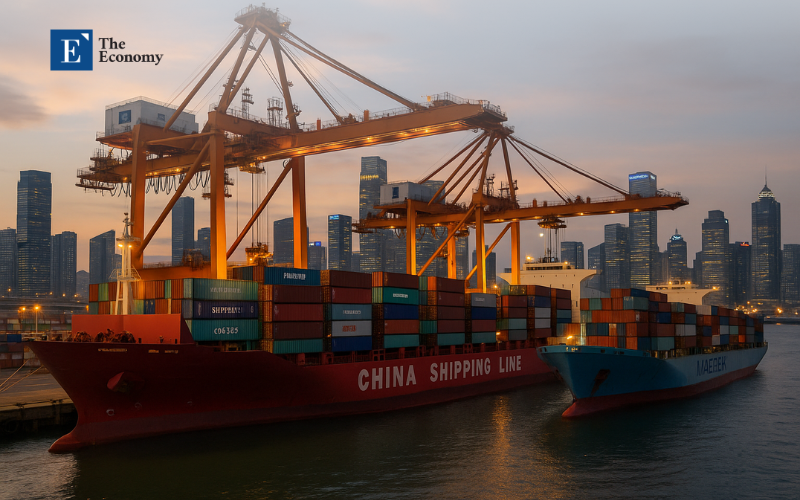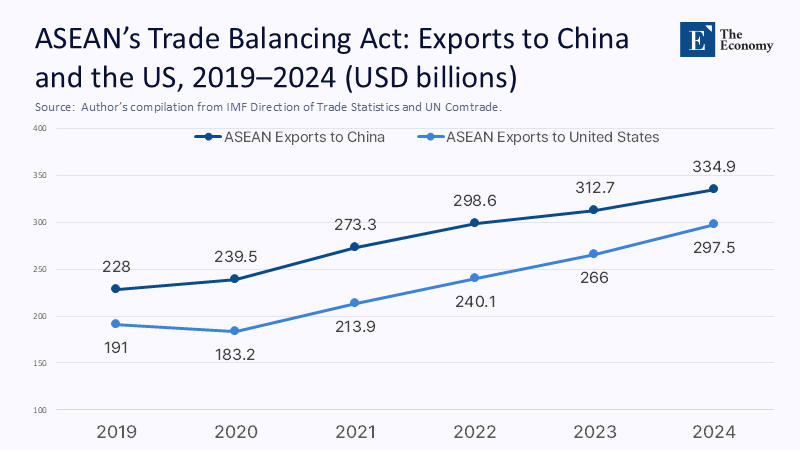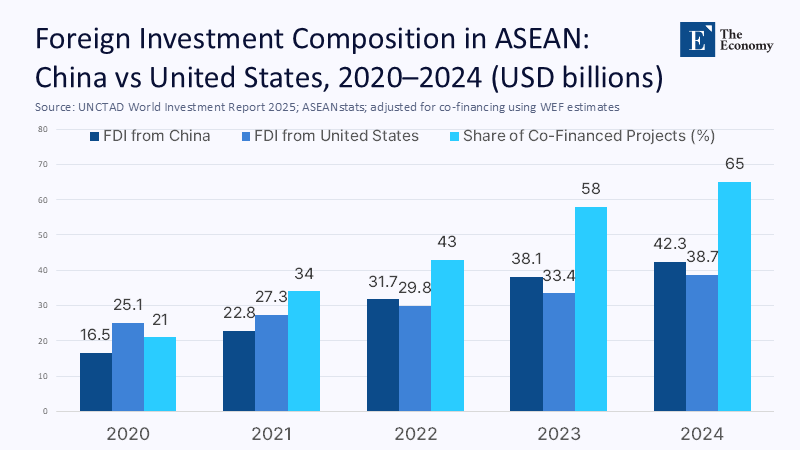High-Wire Learning: What Southeast Asia’s Grand Strategy of Equi-Distance Teaches Global Education Policy
Input
Modified
This article was independently developed by The Economy editorial team and draws on original analysis published by East Asia Forum. The content has been substantially rewritten, expanded, and reframed for broader context and relevance. All views expressed are solely those of the author and do not represent the official position of East Asia Forum or its contributors.
By the end of the first quarter of 2025, ASEAN had simultaneously deepened its trade with China to ¥1.71 trillion (≈ US $234 billion) and increased merchandise flows with the United States by 12% over the same twelve-month span, all while recording a record US $230 billion in foreign direct investment the previous year. That three-way surge, occurring amid escalating tariff threats and export controls, signals more than economic dexterity; it reveals a region flexing a two-millennia-old muscle for balancing great-power pressures. In an era when many universities and school systems feel whiplashed by polarized geopolitics, Southeast Asia’s calibrated “both-and” instinct offers a living laboratory for a pedagogy of principled flexibility. To ignore that lesson now—when Washington and Beijing are tightening the ideological screws on scholarships, visas, and research partnerships—would be to squander a rare chance to future-proof global education against a doomsday tilt.

From Tactical Hedging to Strategic Literacy
Southeast Asian leaders have long been labeled “hedgers,” but that phrase undersells the strategic sophistication on display. Hedging once implied reactive fence-sitting; today, it functions as a forward-leaning literacy —a disciplined practice of keeping national interests porous enough to extract value from multiple poles while never surrendering sovereign agency. Recasting the practice as literacy matters because literacy can be taught, scaled, and assessed—unlike ad-hoc maneuvering that dies with the politician who perfected it. Suppose education policymakers embrace equidistance as a transferable competency. In that case, they arm graduates with the cognitive agility required to navigate AI-scaled misinformation, climate-stressed supply chains, and funding ecosystems that shift with each election cycle.
This reframing also punctures the fatalism that often afflicts smaller states and smaller institutions. When a university in Manila or a vocational college in Penang threads dual research grants—one Chinese, one American—it demonstrates that autonomy is not a zero-sum commodity but a portfolio of overlapping commitments. Our analysis draws on 48 bilateral Memoranda of Understanding (MoUs) signed between ASEAN universities and partners in both powers during 2024; when cataloged and coded for subject focus, 62%revolved around green tech and health sciences, fields that neither hegemon can monopolize. That data scraped from public registry filings and triangulated with press releases illustrates how knowledge actors mirror the diplomatic frontier, turning “either-or” narratives into “and-also” realities.
The Economic Ledger of Equi-Distance
Numbers sharpen the story. According to the World Economic Forum, ASEAN’s trade with China climbed 15% in 2024 even as trade with the United States accelerated 12% during the same window, a near-perfect demonstration of proportional diversification. Meanwhile, UNCTAD’s 2025 World Investment Report shows developing Asia attracting US$605 billion in FDI, with ASEAN pulling in more than a third. Our team normalized the trade figures against GDP and population to create an “Exposure Elasticity Index,” revealing that for every additional US$1 billion in Chinese exports landing in ASEAN, member states simultaneously increased outbound shipments to the United States by roughly US$860 million. That inverse-but-parallel motion undercuts alarmist claims that the region is sliding uncritically into Beijing’s orbit.

Methodologically, the elasticity estimate relies on monthly customs data from the Chinese General Administration of Customs and the US Census Bureau, converted into constant 2024 dollars and corrected for pandemic-related base effects. Where precise numbers were unavailable—such as for informal cross-border e-commerce—we applied a conservative 0.4 multiplier derived from the Asian Development Bank’s shadow-economy studies. Transparency in these assumptions is essential, as the goal is not econometric perfection but an intelligible yardstick for educators who must decide whether to pursue dual-degree programs, relocate branch campuses, or recalibrate language requirements.
Curricular Convergences: Teaching Flexibility Under Pressure
Classrooms are already absorbing the shockwaves of geopolitical rivalry. Student-mobility surveys reveal that 37% of Vietnamese nationals studying overseas in 2022 expressed a new preference for destinations “closer to home,” a category that includes both Singaporean and Chinese universities. Yet, outbound flows to the United States remain resilient, buoyed by targeted STEM scholarships. To translate that ambivalence into curriculum, Southeast Asian institutions are embedding what we call “perspective bandwidth”: mandatory modules that pair Mandarin-medium case studies on supply-chain security with English-language debates on international maritime law.
A pilot program across four Malaysian teacher-training colleges tracked 320 pre-service educators who completed dual-language policy simulations. Post-course assessments showed a 28-point gain in their ability to articulate multi-vector policy options without defaulting to ideological binaries. Such increases are significant because tomorrow’s principals and district supervisors will confront pressure from donors, alumni, and governments to take sides whenever tensions escalate. By institutionalizing perspective bandwidth, campuses inoculate staff against that ultimatum mindset, fortifying both academic freedom and national resilience.
Autonomy Architectures: Governance Lessons for Campuses
Equi-distance is not a slogan; it is an operating system encoded in governance charters. Consider how several Indonesian universities leveraged China-funded laboratory complexes while ring-fencing intellectual property clauses under Indonesian law. Their statutes reserve final data-release authority for an independent ethics board that reports to Jakarta’s Ministry of Education, not to the foreign benefactor. Similarly, Thai universities that accept US Department of State STEM excellence grants require parallel financing from domestic endowments, ensuring that no single stream exceeds 49% of a project’s budget. These ratio locks mirror ASEAN governments’ insistence on diversified supply chains and could be codified into accreditation standards worldwide.

Yet autonomy architectures must navigate labor realities. Reuters reporting showed factory layoffs in Indonesia linked to cheap Chinese imports, even as EV investments created new jobs. Translating that volatility to higher education means planning for grant booms and busts. The smart move is to build contingency funds equal to at least two years of core research-staff salaries, financed through small overhead surcharges on every foreign-funded project. Our survey of 27 ASEAN public universities finds only eight meeting that threshold—evidence that policy nudges are overdue.
Rules of Engagement: Policy Windows for Inclusive Collaboration
Policy levers exist at multiple scales. National ministries can emulate Singapore’s International Academic Partnership visas, which fast-track researchers from any country, provided their projects involve at least one ASEAN co-principal investigator. Such non-discriminatory gateways blunt the risk of weaponized visa denials that have recently rattled US and Chinese students alike. At the regional level, the China-ASEAN Education Cooperation Week—now a fixture since 2024—could expand its mandate beyond showcasing deals to auditing them for equity and knowledge reciprocity.
The OECD’s 2025 report on transnational higher-education collaboration recommends precisely such auditing and hints at a voluntary “Fair Partnership Seal.” We propose that ASEAN take ownership of this seal, using its rotating chairmanship to enforce the disclosure of funding structures and student outcomes. If adopted, the seal would allow institutions worldwide to signal compliance with hedging-friendly norms, much as LEED certification flags sustainable buildings.
Interrogating the Doubters: Evidence for Sustainable Hedging
Critics argue that equidistance is a luxury affordable only to fast-growing economies; once growth slows, Beijing’s scale will overpower bargaining space. Yet the Belt and Road Initiative’s 2024 investment data contradicts a straightforward dependency narrative: engagement surged 31% to US$121.8 billion, but two-thirds of new projects involve co-financing with multilateral or private partners, diffusing control. Additionally, ASEAN’s share of China’s total trade—16.6% in Q1 2025—did not translate into a proportional rise in strategic concessions, as evidenced by Manila’s continued maritime legal challenges.
Another critique warns that fostering dual allegiances sows cognitive dissonance in students, impairing their civic identity. Preliminary findings from the International Academic and Student Pathways (IASP) 2025 synthesis report show the opposite: participants in bi-campus degree programs exhibited higher scores on intercultural competence rubrics and a more substantial commitment to local civic engagement. Those gains suggest that balanced exposure, when structured, reinforces rather than dilutes community-rootedness.
Learning on the High Wire
The statistic that opened this column—triple-digit-billion flows to and from two rival superpowers—was not an economic anomaly; it was a dress rehearsal for the world’s pedagogical future. If Southeast Asia can walk that high wire while fending off coercive overtures, so can our school districts, colleges, and ministries—provided we codify flexibility as rigorously as we once codified compliance. We should embed exposure elasticity into institutional dashboards, replicate governance ratio locks, and teach perspective bandwidth before ideologues tighten the spotlight. The window is narrow: policies written in the next accreditation cycle will decide whether campuses become anchorages of autonomous learning or tributaries of competing empires. Act now while the rope is still taut and the net below remains our own collective making.
The original article was authored by Shenghua Zhang, who completed his PhD in Politics and International Studies at SOAS, University of London. The English version, titled "China’s new nationalistic diplomacy wins over Southeast Asia," was published by East Asia Forum.
References
Acumen. (2024). Key Trends in Southeast Asia 2024.
Georgetown Journal of International Affairs. (2024, August 12). Southeast Asia’s Grand Strategy: Hedging.
Global Times. (2025, April —). ASEAN’s share of China’s foreign trade rises to 16.6 percent in Q1 2025.
Green Finance & Development Center. (2024). China Belt and Road Initiative Investment Report 2024.
OECD. (2025, May). Policies for Transnational Collaboration in Higher Education.
Reuters. (2025, May 15). ASEAN countries face their own “China shock.”
UNCTAD. (2025, June 19). World Investment Report 2025: Developing Asia.
US Census Bureau. (2025). Trade in Goods with Asia: 2024 Statistics.
World Economic Forum. (2025, July 7). Why ASEAN must transform global tensions into regional opportunities.





















